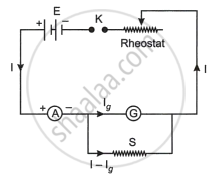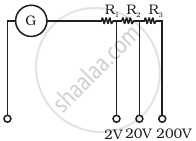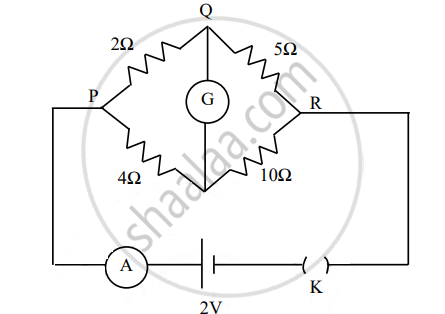Advertisements
Advertisements
प्रश्न
State how a moving coil galvanometer can be converted into an ammeter.
How will you convert a moving coil galvanometer into an ammeter?
Briefly explain why and how a galvanometer is converted into an ammeter.
उत्तर १
- A moving-coil galvanometer is transformed into an ammeter by connecting a low-resistance S across the coil and lowering its effective resistance.
- A shunt is a parallel low resistance that shunts a portion of the current around the coil, as seen in the image below. As a result, the range of currents over which the metre can be used is expanded.

Ammeter - Let I be the maximum current to be measured and Ig be the current for which the galvanometer of resistance G shows a full-scale deflection. Then, the shunt resistance S should be such that the remaining current I - Ig = IS is shunted through it.
- The potential difference across the galvanometer in the parallel combination is equivalent to the potential difference across the shunt.
∴ IgG = IsS = (I - Ig)S
∴ S = `("I"_"g"/("I" - "I"_"g"))"G"`
उत्तर २
Only small currents may be detected by a galvanometer. Thus, it is transformed into an ammeter to measure enormous currents. By joining a low resistance known as a shunt resistance in parallel with the galvanometer, it can be transformed into an ammeter.
Let S be the low resistance connected in parallel with the galvanometer, G be the resistance of the galvanometer, and I be the maximum current to be measured for full-scale deflection in the galvanometer. Since the galvanometer and shunt resistances are connected in parallel.
∴ The potential difference across 'S' = Potential difference across G
(I - lg)S = lgG

Notes
Students should refer to the answer according to their questions and marks.
APPEARS IN
संबंधित प्रश्न
The combined resistance of a galvanometer of resistance 500Ω and its shunt is 21Ω. Calculate the value of shunt.
A rectangular coil of a moving coil galvanometer contains 50 turns each having area 12 cm2 . It is suspended in radial magnetic field 0.025 Wb/m2 by a fibre of twist constant 15 x10-10 Nm/degree. Calculate the sensitivity of the moving coil galvanometer.
Show that the current flowing through a moving coil galvanometer is directly proportional to the angle of deflection of coil.
Why does a galvanometer show a momentary deflection at the time of charging or discharging a capacitor? Write the necessary expression to explain this observation.
An ideal voltmeter has _______.
(A) low resistance
(b) high resistance
(C) infinite resistance
(D) zero resistance
A galvanometer of resistance G is converted into a voltmeter to measure upto V volts by connecting a resistance R1 in series with the coil. If a resistance R2 is connected in series with it, then it can measures upto V/2 volts. Find the resistance, in terms of R1 and R2, required to be connected to convert it into a voltmeter that can read upto 2 V. Also find the resistance G of the galvanometer in terms of R1 and R2
Draw a labelled diagram of a moving coil galvanometer. Describe briefly its principle and working.
Why is it necessary to introduce a cylindrical soft iron core inside the coil of a galvanometer?
Increasing the current sensitivity of a galvanometer may not necessarily increase its voltage sensitivity. Explain, giving reason.
Two moving coil meters, M1 and M2 have the following particulars:
R1 = 10 Ω, N1 = 30,
A1 = 3.6 × 10–3 m2, B1 = 0.25 T
R2 = 14 Ω, N2 = 42,
A2 = 1.8 × 10–3 m2, B2 = 0.50 T
(The spring constants are identical for the two meters).
Determine the ratio of
- current sensitivity and
- voltage sensitivity of M2 and M1.
Explain how moving coil galvanometer is converted into a voltmeter. Derive the necessary formula.
A rectangular coil of a moving coil galvanometer contains 100 turns, each having area
15 cm2. It is suspended in the radial magnetic field 0.03 T. The twist constant of suspension
fibre is 15 x 10-10 N-m/degree. Calculate the sensitivity of the moving coil galvanometer.
The fraction of the total current passing through the galvanometer is ............ .
a) `S/(S+G)`
b) `G/(S+G)`
c) `(S+G)/G`
d) `(S+G)/S`
A moving coil galvanometer has a resistance of 25Ω and gives a full scale deflection for a current of 10mA. How will you convert it into a voltmeter having range 0 - 100 V?
A galvanometer has a resistance of 16Ω. It shows full scale deflection, when a current of 20 mA is passed through it. The only shunt resistance available is 0.06 which is not appropriate to convert a galvanometer into an ammeter. How much resistance should be connected in series with the coil of galvanometer, so that the range of ammeter is 8 A?
Why is it necessary to introduce a radial magnetic field inside the coil of a galvanometer?
Can a galvanometer as such be used for measuring the current? Explain.
Why does a galvanometer when connected in series with a capacitor show a momentary deflection, when it is being charged or discharged?
How does this observation lead to modifying the Ampere's circuital law?
Hence write the generalised expression of Ampere's law.
Write current sensitivity of a galvanomete S.I. unit.
Draw a labelled diagram of a moving coil galvanometer and explain its working. What is the function of radial magnetic field inside the coil?
In the meter bridge experiment, balance point was observed at J with AJ = l.
(i) The values of R and X were doubled and then interchanged. What would be the new position of balance point?
(ii) If the galvanometer and battery are interchanged at the balance position, how will the alance point get affected?

State the principle of the working of a moving coil galvanometer, giving its labeled diagram ?
Outline the necessary steps to convert a galvanometer of resistance RG into an ammeter of a given range ?
A coil of radius 10 cm and resistance 40 Ω has 1000 turns. It is placed with its plane vertical and its axis parallel to the magnetic meridian. The coil is connected to a galvanometer and is rotated about the vertical diameter through an angle of 180°. Find the charge which flows through the galvanometer if the horizontal component of the earth's magnetic field is BH = 3.0 × 10−5 T.
Why are the pole pieces of a horseshoe magnet in a moving coil galvanometer made cylinder in shape?
Explain the significance of a radial magnetic field when a current-carrying coil is kept in it.
A galvanometer coil has a resistance of 12 Ω and the metre shows full scale deflection for a current of 3 mA. How will you convert the metre into a voltmeter of range 0 to 18 V?
A galvanometer coil has a resistance of 15 Ω and the metre shows full scale deflection for a current of 4 mA. How will you convert the metre into an ammeter of range 0 to 6 A?
The deflection in a moving coil galvanometer is ______.
The current sensitivity of a galvanometer is defined as ______.
A moving coil galvanometer can be converted into an ammeter by ______.
The conversion of a moving coil galvanometer into a voltmeter is done by ______.
The coil of a moving coil galvanometer is wound over a metal frame in order to ______.
The current sensitivity of a galvanometer increase by 20%. If its resistance also increases by 25%, the voltage sensitivity will ______.
Assertion (A): On Increasing the current sensitivity of a galvanometer by increasing the number of turns may not necessarily increase its voltage sensitivity.
Reason (R): The resistance of the coil of the galvanometer increases on increasing the number of turns.
Select the most appropriate answer from the options given below:
A galvanometer having a coil resistance of 60 Ω shows full-scale deflection when a current of 1.0 amp passes through it. It can be converted into an ammeter to read currents up to 5.0 amp by:
In an ammeter 0.5% of main current passes through galvanometer; If resistance of galvanometer is G, the resistance of ammeter will be.
The coil of galvanometer consists of 100 turns and effective area of 1 square cm. The restoring couple is 10-8 N-m/rad. The magnetic field between the pole pieces is 5T. The current sensitivity of this galvanometer will be ______.
A multirange voltmeter can be constructed by using a galvanometer circuit as shown in figure. We want to construct a voltmeter that can measure 2V, 20V and 200V using a galvanometer of resistance 10Ω and that produces maximum deflection for current of 1 mA. Find R1, R2 and R3 that have to be used.

When a galvanometer is shunted with a 4 Ω resistance, the deflection is reduced to one-fifth. If the galvanometer is further shunted with a 2 Ω wire. The further reduction (find the ratio of decrease in current to the previous current) in the deflection will be (the main current remains the same)
A galvanometer coil bas 500 turns and each tum has an average area of 3 × 10-4 m2. If a torque of 1.5 Nm is required to keep this coil parallel to a magnetic field when a current of 0.5 A is flowing through it, the strength of the field (in T) is ______.
A galvanometer having a resistance of 20 Ω and 30 Ω division on both sides has figure of merit 0.005 ampere/division. The resistance that should be connected in series such that it can be used as a voltmeter upto 15 volt, is ______.
A moving coil galvanometer has 150 equal divisions. Its current sensitivity is 10-divisions per milliampere and voltage sensitivity is 2 divisions per millivolt. In order that each division reads 1 volt, the resistance in ohms needed to be connected in series with the coil will be ______.
How is current sensitivity increased?
Explain in brief the basic construction of a moving-coil table galvanometer whit a neat labelled diagram.
A resistance of 3Ω is connected in parallel to a galvanometer of resistance 297Ω. Find the fraction of current passing through the galvanometer.
A moving coil galvanometer of resistance 55 Ω produces a full scale deflection for a current of 250 mA. How will you convert it into an ammeter with a range of 0 - 3A?
To convert a moving coil galvanometer into an ammeter we need to connect a ______.
The figure below shows a circuit containing an ammeter A, a galvanometer G and a plug key K. When the key is closed:

A galvanometer of resistance 100 Ω gives a full-scale deflection for a potential difference of 200 mV.
- What must be the resistance connected to convert the galvanometer into an ammeter of the range 0-200 mA?
- Determine resistance of the ammeter.
